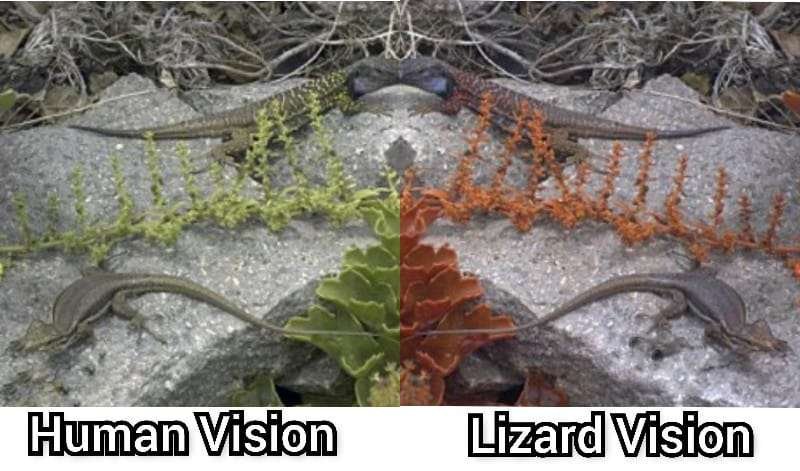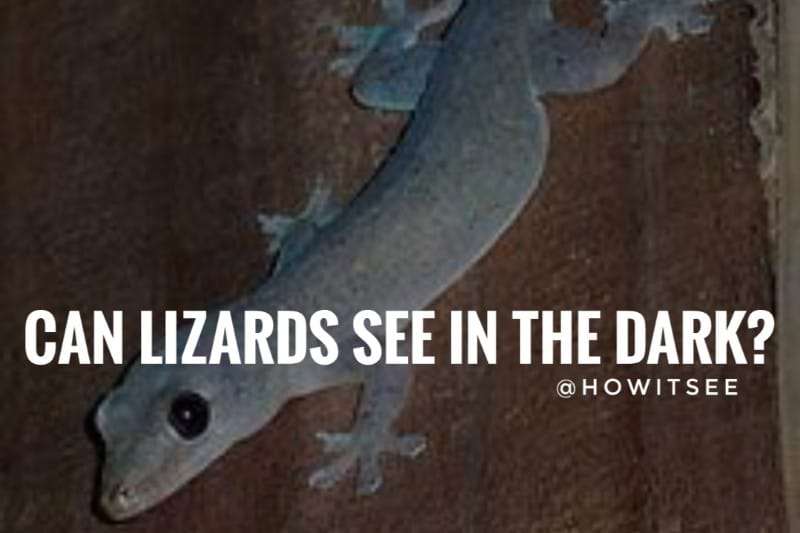Lizards are the reptiles of suborder Lacertilia found worldwide (except Antarctica) with more than 6,000 species. They have been ubiquitous among people. Numerous lizards or reptiles are kept as pets, like bearded dragons, iguanas, anoles, etc.; some species are prevalent in mythologies, and a portion of genus like the house lizards can be seen in any household. But have you ever been fascinated by how lizards glimpse the world, or can they see in the dark?
Lizards can see in the dark with the help of the light-sensitive rods in their eyes. However, their ability to see clearly in the dark totally depends on their species, environment, and habitat. They do not have tapetum lucidum in their eyes. Therefore, their eyes are evolute depending on the habitat and surroundings. Diurnal lizards cannot perceive very well in the dark, whereas nocturnal lizards can visually discern, hunt, travel, and even perceive colors.
Lizards are predominantly dependent on their vision. Therefore, their eyes are well-developed compared to other reptiles. Later in this post, we have discussed more on lizard vision in detail. So, let’s begin.
Can Lizards see in the Dark? (House Lizards)
Yes, many lizards can see in the dark. They have developed many light-sensitive rods in their eyes to sense even the slightest movements in the complete darkness. Lizards primarily rely on their eyes to accomplish daily activities like hunting and traveling. However, the ability to see, hunt, and travel in the dark is developed based on their species and habitat.
Remember- Rods in the eyes help to perceive the light’s brightness and are responsible for seeing better in the low light condition. On the other hand, cones assist in recognizing the color shades and clarity.
The human eye has more cones than rods. That’s why we can see much better during the day and cannot notice anything at night.

Example: House lizards or Geckos are nocturnal, and over the period, they developed the ability to glimpse in the low light conditions. Therefore, you can witness them traveling or eating primarily at night in your house.
Nocturnal lizards have larger pupils that comprise more rods than cones, granting them to perceive even the slightest of the light.
Not only this, but they can differentiate some colors even in the dark. The research was done on geckos to feed them in colored tongs under dim moonlight. The result proved that geckos could distinguish the difference between the two. In fact, their eyes can be 350 times more sensitive than ours.
On the other hand, diurnal reptiles like the Bearded dragon cannot see well in the dark. They have more cones than rods in their eyes. They are tetrachromats means the cones in their eyes perceive blue, green, and red colors along with ultraviolet light.
Even humans are trichromats and can only see millions of color shades within the visible spectrum. In addition, bearded dragons also have a parietal eye, the third eye, that assists them in detecting shadows and the changes in light. However, it does not improve their poor night vision.
In a nutshell, “can lizards see in the dark” mainly leans on their species, habitat, and environment.
Can Lizards see color?
Lizards can see colors, but their color differentiation ability predominantly depends on species and habitat. All lizards have photoreceptors in their eyes that possess the different types of cones, permitting them to distinguish the various hues.
For example, leopard geckos are trichromatic by nature but can identify violet, blue and green hues much better than red shades. They have good color vision even in dim light conditions.
On the other side, bearded dragons (reptiles) are tetrachromats, which means they can recognize small, medium, and large wavelength colors. They can see visible spectrum as well as ultraviolet light. In concise, they have the proficiency in distinguishing more colors that are even invisible to a human eye.
Humans are trichromatic and can distinguish blue, green, and red hues from 380 nm to 720 nm wavelength. Like gecko and bearded dragons, the eyesight of lizards comprehensively relies on their surroundings and evolution, and every lizard species recognize colors differently.
Do Lizards have Good Eyesight?
Lizards have very good eyesight compared to other reptiles. They rely mainly on their vision to search for food, sense predators, and select mates. In terms of clarity, they have a very clear vision but slightly less than humans.
Lizards can focus on far as well as the nearby entities by squeezing their eye lens, which helps them estimate the distance. Here, ciliary muscles play a significant role in changing the lens shape of lizards, turtles, and crocodilians to focus on near objects. And this process is called accommodation.
In addition, lizards’ habitat and surrounding also describe their eyesight. For example, Nocturnal lizards like the leopard gecko have larger pupils and cornea that comprise more rods than cones. It improves their ability to see movements, colors, and shapes in low-light conditions but in exchange for visual acuity.
On the other hand, diurnal reptiles like bearded dragons and blue tongue skinks have better eyes comprising more cones than rods that assist them in distinguishing millions of color variations with high clarity but in exchange for night vision.
How do Lizards see the world?
Lizards have sharp vision and see the world with colors and clarity. Most diurnal lizards can see in ultraviolet light and recognize more colors than humans. They perceive a more comprehensive range of the electromagnetic spectrum. Below we have attached an image to compare lizard vision with human vision and how they see the world.

As illustrated in the image, lizards have the same sharpness in their vision when it comes to focusing on nearby objects. But they see the world in different colors due to the capability of perceiving ultraviolet light. Like humans, diurnal lizards are not able to witness anything in the dark.
However, nocturnal lizards have the opposite vision. Holding more rods in their eyes grants them to notice clearly in the dark but in less clarity.
Do Lizards like Dark or Light?
Nocturnal lizards like geckos can see much better in the dark. Therefore, they like to travel or hunt at night. In contrast, diurnal reptiles like bearded dragons can witness their surroundings with colors and clarity during the daytime. Hence, they like to move in the light. Hence, what lizards like is primarily dependent on their species and habitat.
Are Lizards scared of Humans?
Lizards are scared of everything that are bigger and more dangerous than them. Not only humans, lizards like geckos also avoid big frogs, centipedes, tarantulas, scorpions, etc., that are far more frighting than them.
Lizards categorize prey or predators based on their size and physical appearance. Below we have attached a video on lizard vs centipede vs crab vs scorpion.
Lizard vision vs Human vision-
| Lizard vision | Human vision |
| Lizards can be trichromatic or tetrachromatic, depending on the species. | Humans are trichromats. |
| Most lizards can see ultraviolet light. | We cannot see ultraviolet light. |
| Some lizards can discern visually in the dark. | Humans do not have the ability to see in the dark. |
Here, we conclude our article on “Can Lizards see in the Dark,” along with other explanations of its vision. We hope you like this post. We will be back with another article. Till then, stay tuned and stay healthy.
References-
Image Source- Daily Mail
Video Source- Animal Secrets @YouTube
See the world through an animal’s eyes by Mail Online
Also Read:

Meet Abhidept (nickname Monty), the visionary founder of How It See, being an engineering student, he’s fueled by an insatiable curiosity about the world around him. He is captivated by an eclectic correlation between animal groups, science, and nature, and this fascination drives his quest for understanding.
After completing his degree, he’s set on a mission to delve deep into the realm of nature, accumulating knowledge to share with you through his writing. In the meantime, he loves to watch anime and read anime.
